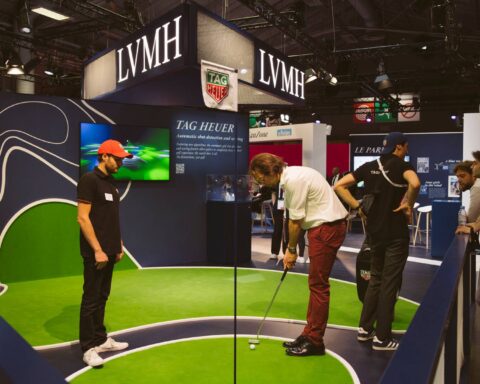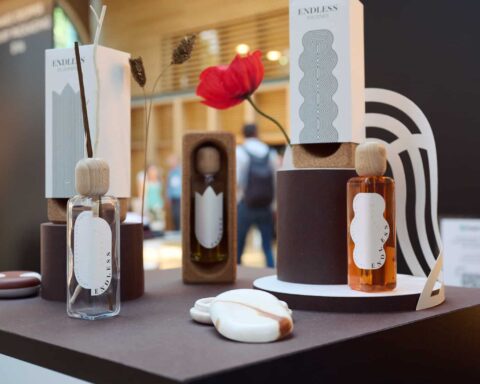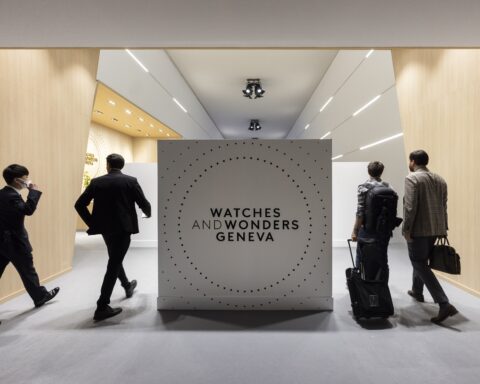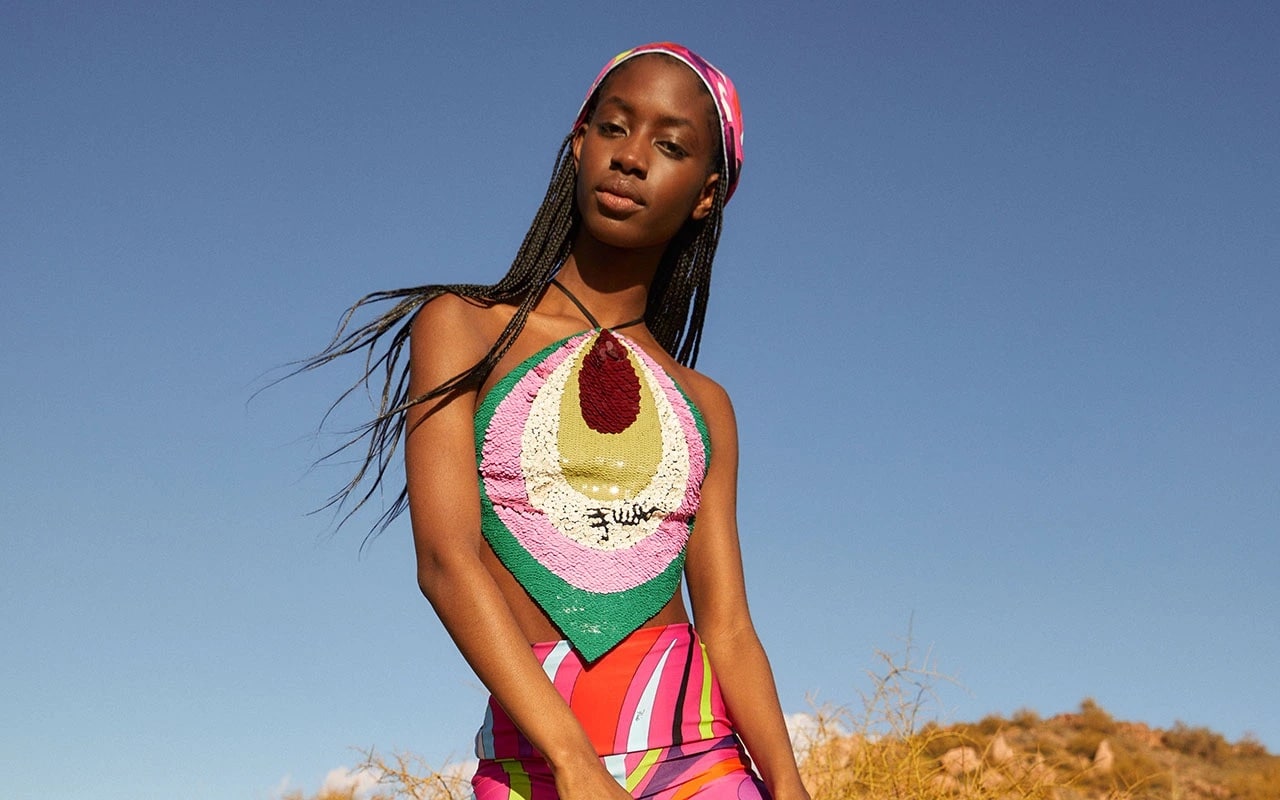[vc_row njt-role=”people-in-the-roles” njt-role-user-roles=”administrator,editor,author,armember”][vc_column][vc_column_text]
Department stores and luxury boutiques compete in ingenuity to capture the attention of their customers and arouse their desire. More than a scenographic design, it is about knowing and serving the customer better. In this field, they can make the difference with e-commerce platforms unable to provide a wide range of emotions born of a unique, memorable, and fundamentally human customer experience.
Dive into the heart of retail, the historical model of luxury distribution, in the light of the post-Covid era and the extended virtual worlds of Web 3.
The aftermath of recovery or the rebirth of physical retail
Last January, the NRF Retail Big Show opened in New York, a key event for distribution and retail professionals, including those in the luxury sector. For the first time without capacity constraints since before Covid, the event highlighted e-commerce solutions, contrasting with previous editions focused on retail experiences in stores. A development that is understandable given the growing share of e-commerce in luxury goods purchases: +44% between 2017 and 2019, according to the latest Bain-Altagamma study, entitled Renaissance in Uncertainty: Luxury Builds on Its Rebound, published in January 2023.
A sign that e-commerce has definitely triumphed over retail? Not quite. In fact, today, only 20% of the global turnover of the luxury goods industry (estimated at 1,400 billion euros in 2022) is achieved via e-commerce, compared to 80% in stores.
Retail sales are more alive than ever
Also, according to Bain, the growth of e-commerce between 2019 and 2021 was established at 92%. The temporary closure of physical retail outlets has decomplexed the clientele of luxury brands, seeing it as the only alternative to continuing to indulge in the comfort of their home. As Delphine Vitry, co-founder of MAD, a consulting firm specializing in luxury, explains, “In two years, the major Houses have accelerated their digital transition, not so much with a view to financial performance as to consolidate their omnichannel culture.”
The sales ceremony can thus start from anywhere, not only from the store or the e-commerce site.
When it reopened, the store still appeared to be a potential source of contagion. Enough to not give much hope to its future, despite the implementation of contactless devices, especially in the beauty world.
This was without counting on a certain weariness of relationships via screen: the growth of online purchases of luxury goods was only 20% between 2021 and 2022, according to the same Bain study.
Millennials and Gen Z are rediscovering the physical store
And today, we’re seeing a rebalancing of customers’ preferred distribution channels, now much more in favor of the physical store, especially among Millennials and Gen Z. “There is a real attachment to the in-store luxury experience, from first-time buyers, especially among the younger generations who now represent between 30 and 40% of customers,” explains Nicolas Rebet, consultant and founder of Retailoscope, a firm specializing in retail.
Numerous studies confirm that while members of Generation Z (20 years old and under) are much more comfortable buying luxury goods online than their older brothers and sisters, Millennials (25-35 years old), trying them on in-store remains a determining factor in their choice.
Despite a slowdown in the opening of new locations between 2013 and 2021 – in favor of renovations and refurbishments – “luxury brands are still making real and serious investments in their flagship stores in the major luxury markets (Milan, Paris, Tokyo, Shanghai, Singapore, but also London and New York)”. It is worth noting that while the luxury department store model is doing well in China, Dubai, and Paris, it is dead in the United States. The innovative retail concepts that once characterized the Big Apple are also absent. References like the House of Innovations 000 – Nike’s true hub store – have moved away from their experiential strategy since the covid to the point of becoming purely transactional. On the other hand, London is suffering the effects of the abolition of its tax-free service, encouraging tourists to postpone their purchases to other luxury locations such as Paris or Milan.

Milan in the sights
In Europe, Milan – which is to host the 2026 Winter Olympics in the resort of Cortina D’Ampezzo – is currently the focus of investments by luxury brands. The city has no fewer than four Chanel points of sale – some of which are being renovated – while Gucci, Louis Vuitton, and Etro are busy renovating their boutiques. Chopard, Harry Winston, and Christian Louboutin are planning to open theirs in 2023. But Paris is not to be outdone, with the forthcoming opening of the largest flagship store of the Gucci brand in the Place Vendôme district, opposite that of Vuitton.
Outside of historic destinations, Los Angeles, Seoul, Mexico City and Sydney, as well as second-tier cities in the United States and China (Dallas, Michigan, Chicago, Charlotte as well as Shenzhen and Nanjing), are favored by luxury brands.
Another major change is the place of technology in the store and its role in the customer experience. For department stores, hard hit by health restrictions, suffering from the loss of tourists – particularly Chinese – and the rise of e-commerce competition (third-party multi-brands and second-hand stores), the digitalization of the experience appears to be a priority.

Leaving it to the House of Dior to orchestrate the in-store animations and illuminations of its mythical 1901 Edwardian terracotta façade last December, Harrods, the London luxury department store, presented its strategic partnership with the e-commerce platform Farfetch at the NRF trade show. Its managing director, Michael Ward, reminded the audience of the need for a physical store like Harrods to differentiate itself and to rely on synergies with tech partners; otherwise, it will disappear.

Wholesale-retail parity
But behind the alarmist tone, there is a reality that was already at work before Covid: the year-on-year decrease in the share of wholesale distribution in the sale of luxury products. Luxury brands are anxious to preserve their margins and fight against the risk of trivializing their offer as much as diluting their image, so luxury brands continue to regain control over their distribution. As a result, the share of wholesale sales has risen from 72% of luxury goods sales in 2010 to 60% in 2019, and will reach perfect parity (50%) with the retail model for the first time in 2022, according to the latest Bain report.
If the in-store experience cannot rely on technology alone to be conclusive and engaging, mastering data is a key factor in the quest for an omnichannel customer experience. The latter must be satisfactory and consistent across all of the brand’s touch points.
In Nicolas Rebet’s opinion, technological innovation is becoming more and more invisible at the point of sale. Gone is the 2012-2018 period when luxury brands equipped their stores with giant screens and other connected mirrors, as the tailor Brioni in Milan or the designer Rebecca Minkoff in New York had deployed.

The recent inauguration of Burberry’s new flagship on Sloane Street is a testament to the theatricality and sensoriality of materials with a trench coat in majesty, and this, without technological gadgets. Nothing to do with the historic flagship at 121 Regent Street, designed in 2013 as “an e-commerce site turned into a physical store” where technology was visible on its four floors. This logic of declining from physical to virtual has even been reversed: the e-commerce platform curating vintage pieces and partner designers Gucci Vault opened its physical store last year.
Read also > Gucci Salon: first ultra-luxury boutique opens in Los Angeles
Featured photo : ©Presse[/vc_column_text][/vc_column][/vc_row][vc_row njt-role=”not-logged-in”][vc_column][vc_column_text]
Department stores and luxury boutiques compete in ingenuity to capture the attention of their customers and arouse their desire. More than a scenographic design, it is about knowing and serving the customer better. In this field, they can make the difference with e-commerce platforms unable to provide a wide range of emotions born of a unique, memorable, and fundamentally human customer experience.
Dive into the heart of retail, the historical model of luxury distribution, in the light of the post-Covid era and the extended virtual worlds of Web 3.
The aftermath of recovery or the rebirth of physical retail
Last January, the NRF Retail Big Show opened in New York, a key event for distribution and retail professionals, including those in the luxury sector. For the first time without capacity constraints since before Covid, the event highlighted e-commerce solutions, contrasting with previous editions focused on retail experiences in stores. A development that is understandable given the growing share of e-commerce in luxury goods purchases: +44% between 2017 and 2019, according to the latest Bain-Altagamma study, entitled Renaissance in Uncertainty: Luxury Builds on Its Rebound, published in January 2023.
A sign that e-commerce has definitely triumphed over retail? Not quite. In fact, today, only 20% of the global turnover of the luxury goods industry (estimated at 1,400 billion euros in 2022) is achieved via e-commerce, compared to 80% in stores.
Retail sales are more alive than ever
Also, according to Bain, the growth of e-commerce between 2019 and 2021 was established at 92%. The temporary closure of physical retail outlets has decomplexed the clientele of luxury brands, seeing it as the only alternative to continuing to indulge in the comfort of their home. As Delphine Vitry, co-founder of MAD, a consulting firm specializing in luxury, explains, “In two years, the major Houses have accelerated their digital transition, not so much with a view to financial performance as to consolidate their omnichannel culture.”
The sales ceremony can thus start from anywhere, not only from the store or the e-commerce site.
When it reopened, the store still appeared to be a potential source of contagion. Enough to not give much hope to its future, despite the implementation of contactless devices, especially in the beauty world.
This was without counting on a certain weariness of relationships via screen: the growth of online purchases of luxury goods was only 20% between 2021 and 2022, according to the same Bain study.
Millennials and Gen Z are rediscovering the physical store
And today, we’re seeing a rebalancing of customers’ preferred distribution channels, now much more in favor of the physical store, especially among Millennials and Gen Z. “There is a real attachment to the in-store luxury experience, from first-time buyers, especially among the younger generations who now represent between 30 and 40% of customers,” explains Nicolas Rebet, consultant and founder of Retailoscope, a firm specializing in retail.
Numerous studies confirm that while members of Generation Z (20 years old and under) are much more comfortable buying luxury goods online than their older brothers and sisters, Millennials (25-35 years old), trying them on in-store remains a determining factor in their choice.
[…][/vc_column_text][vc_cta h2=”This article is reserved for subscribers.” h2_font_container=”tag:h2|font_size:16|text_align:left” h2_use_theme_fonts=”yes” h4=”Subscribe now !” h4_font_container=”tag:h2|font_size:32|text_align:left|line_height:bas” h4_use_theme_fonts=”yes” txt_align=”center” color=”black” add_button=”right” btn_title=”I SUBSCRIBE !” btn_color=”danger” btn_size=”lg” btn_align=”center” use_custom_fonts_h2=”true” use_custom_fonts_h4=”true” btn_button_block=”true” btn_custom_onclick=”true” btn_link=”url:https%3A%2F%2Fluxus-plus.com%2Fen%2Fsubscriptions-and-newsletter-special-offer-valid-until-september-30-2020-2-2%2F”]Get unlimited access to all articles and live a new reading experience, preview contents, exclusive newsletters…
Already have an account ? Please log in.[/vc_cta][vc_column_text]Featured photo : © Presse[/vc_column_text][/vc_column][/vc_row][vc_row njt-role=”people-in-the-roles” njt-role-user-roles=”subscriber,customer”][vc_column][vc_column_text]
Department stores and luxury boutiques compete in ingenuity to capture the attention of their customers and arouse their desire. More than a scenographic design, it is about knowing and serving the customer better. In this field, they can make the difference with e-commerce platforms unable to provide a wide range of emotions born of a unique, memorable, and fundamentally human customer experience.
Dive into the heart of retail, the historical model of luxury distribution, in the light of the post-Covid era and the extended virtual worlds of Web 3.
The aftermath of recovery or the rebirth of physical retail
Last January, the NRF Retail Big Show opened in New York, a key event for distribution and retail professionals, including those in the luxury sector. For the first time without capacity constraints since before Covid, the event highlighted e-commerce solutions, contrasting with previous editions focused on retail experiences in stores. A development that is understandable given the growing share of e-commerce in luxury goods purchases: +44% between 2017 and 2019, according to the latest Bain-Altagamma study, entitled Renaissance in Uncertainty: Luxury Builds on Its Rebound, published in January 2023.
A sign that e-commerce has definitely triumphed over retail? Not quite. In fact, today, only 20% of the global turnover of the luxury goods industry (estimated at 1,400 billion euros in 2022) is achieved via e-commerce, compared to 80% in stores.
Retail sales are more alive than ever
Also, according to Bain, the growth of e-commerce between 2019 and 2021 was established at 92%. The temporary closure of physical retail outlets has decomplexed the clientele of luxury brands, seeing it as the only alternative to continuing to indulge in the comfort of their home. As Delphine Vitry, co-founder of MAD, a consulting firm specializing in luxury, explains, “In two years, the major Houses have accelerated their digital transition, not so much with a view to financial performance as to consolidate their omnichannel culture.”
The sales ceremony can thus start from anywhere, not only from the store or the e-commerce site.
When it reopened, the store still appeared to be a potential source of contagion. Enough to not give much hope to its future, despite the implementation of contactless devices, especially in the beauty world.
This was without counting on a certain weariness of relationships via screen: the growth of online purchases of luxury goods was only 20% between 2021 and 2022, according to the same Bain study.
Millennials and Gen Z are rediscovering the physical store
And today, we’re seeing a rebalancing of customers’ preferred distribution channels, now much more in favor of the physical store, especially among Millennials and Gen Z. “There is a real attachment to the in-store luxury experience, from first-time buyers, especially among the younger generations who now represent between 30 and 40% of customers,” explains Nicolas Rebet, consultant and founder of Retailoscope, a firm specializing in retail.
Numerous studies confirm that while members of Generation Z (20 years old and under) are much more comfortable buying luxury goods online than their older brothers and sisters, Millennials (25-35 years old), trying them on in-store remains a determining factor in their choice.
[…][/vc_column_text][vc_cta h2=”This article is reserved for subscribers.” h2_font_container=”tag:h2|font_size:16|text_align:left” h2_use_theme_fonts=”yes” h4=”Subscribe now !” h4_font_container=”tag:h2|font_size:32|text_align:left|line_height:bas” h4_use_theme_fonts=”yes” txt_align=”center” color=”black” add_button=”right” btn_title=”I SUBSCRIBE !” btn_color=”danger” btn_size=”lg” btn_align=”center” use_custom_fonts_h2=”true” use_custom_fonts_h4=”true” btn_button_block=”true” btn_custom_onclick=”true” btn_link=”url:https%3A%2F%2Fluxus-plus.com%2Fen%2Fsubscriptions-and-newsletter-special-offer-valid-until-september-30-2020-2-2%2F”]Get unlimited access to all articles and live a new reading experience, preview contents, exclusive newsletters…
Already have an account ? Please log in.[/vc_cta][vc_column_text]Featured photo : © Presse[/vc_column_text][/vc_column][/vc_row][vc_row njt-role=”people-in-the-roles” njt-role-user-roles=”subscriber,customer”][vc_column][vc_column_text]











